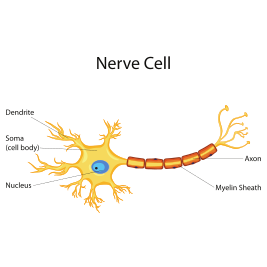
How do EMGs test for neuropathy?
Karen May, DC, CCSP, CCIP
How do EMGs test for Neuropathy?
What is Neuropathy?
If you have experienced pain, numbness, or weakness in your hands or feet - you or your doctor have probably considered that you may have neuropathy. But what is neuropathy?
Neuropathy happens when your nerves become damaged or stop working properly. It can affect the nerves that help you feel, move, or even control different parts of your body.
Because your nerves are everywhere, neuropathy can happen just about anywhere too. The nerves in your hands and feet are the furthest from your spinal cord, so your nerves have to travel the furthest to carry signals to your hands and feet. This makes your hands and feet the common place to experience the painful symptoms of neuropathy.
Without treatment, neuropathy symptoms can get worse over time, making everyday tasks even harder. I know it can feel overwhelming, and so many people go through this quietly, unsure of where to go for relief.

You’re not alone, though—more than 20 million Americans are living with neuropathy right now. Since there aren’t traditional medical treatments that can cure it, it’s frustrating for so many people. Neuropathy has more than 100 known causes, from toxins and medications to injuries, chemotherapy, and more.
There are tools that can help you diagnose neuropathy, an EMG is one of them.
What is an EMG?
An EMG (or electromyography) is a standard medical test that is designed to measure your muscle response or electrical activity in response to a nerve's stimulation of the muscle. This test can help to diagnose a nerve injury, muscle disease, herniated discs, and neuropathy.

An EMG is done in two main steps:
Nerve Conduction Study (NCS): Small sensors are placed on your skin, and a tiny electrical pulse is sent through them to test how well and how quickly your nerves send signals.
Needle EMG: A very thin needle goes into a muscle to measure its electrical activity. This part checks if your muscles are responding correctly to the nerve signals.
Besides the initial insertion of the needle or electrode, EMGs are meant to be painless. However, since neuropathy already makes nerves painful and sore, the electrical impulses of an EMG can intensify those symptoms and may cause more pain during the testing
How does an EMG diagnose neuropathy?
An EMG may help your doctor see how well your nerves are performing and if there are any abnormal muscle responses. This can help your doctor understand the extent of your nerve damage and how badly impacted they are. It can also show conditions like radiculopathy which is more of a nerve disorder that starts in the lower back. While the testing is pretty straight-forward, it is still one test and your doctor should be looking at other tests to help determine the severity of your neuropathy
Here are two ways that can be done:
Slow or weak signals in an EMG can indicate nerve damage that will slow down the speed of your nerve signals.
Abnormal muscle responses in the needle EMG can show if your muscles are receiving proper instructions from your nerve.
With information from the EMG, your doctor can better understand and pinpoint if neuropathy is the cause of your pain and symptoms.
How accurate are EMGs at diagnosing neuropathy?
Every test has its limitations. EMGs are not an exception. While usually accurate for diagnosing neuropathy, nerve fibers have different sizes and make the body do different things. An EMG is most accurate in diagnosing if the large nerve fibers are damaged. You may experience balance issues, tripping over your own feet, not being able to sense vibration, not being able to tell if your feet are touching the gas or brake pedal. Below is a bit more of a breakdown.
Large Fiber Neuropathy: EMGs are the most effective at diagnosing large fiber neuropathy, or neuropathies that impact larger nerves in your body. These larger nerves control movement and sensations like vibration and pressure. EMGs can detect any slowed or blocked nerve signals that may be impacting your larger nerves.
Small Fiber Neuropathy: EMGs are less effective at detecting neuropathies impacted by damage to smaller nerves. These smaller nerves control sensations like temperature and pain. A small fiber skin biopsy is the medical standard for small nerve fiber neuropathy. Here is the kicker: if only an EMG is done, Small Fiber Neuropathy may give normal EMG results. If you have symptoms like waking up at night, burning, sharp, electric sensations, don’t like the sheets on your bed touching you, or have a bunched-up sock feeling when you aren’t even wearing a sock - these are more small fiber neuropathy sensations, and an EMG will miss it.
Early Stage Neuropathy: If your neuropathy is in the early stages, the nerve damage may not be severe enough to be detected by an EMG.
Questions to ask your doctor: While the testing can help your doctor diagnose you, it is important to ask what solutions are available besides covering up the pain or other sensations. If you have already tried the common medication methods of Gabapentin, Lyrica, and Cymbalta to block pain and they just recommend more medications, ask them if there is anything else they can recommend. The reality is that there is no medication designed to rebuild damaged nerves, only to block pain while the nerve damage progressively gets worse.
Neuropathy is a chronic condition that worsens over time. Without treatment, any symptoms you have will progressively get worse.
Get treatment for neuropathy
Neuropathy is a chronic condition that worsens over time. Without treatment, any symptoms you have will progressively get worse.
While there is no cure or quick fix for neuropathy, our proven Neuropathy Relief Program has seen success time and time again:
- Reducing pain and numbness
- Improving balance and mobility
- Improving quality of life and overall health
- Helping clients to regain their freedom and independence
To connect with a relief expert today and learn more about your relief options, call 517-883-2291 or click the button below to learn more about our program.

